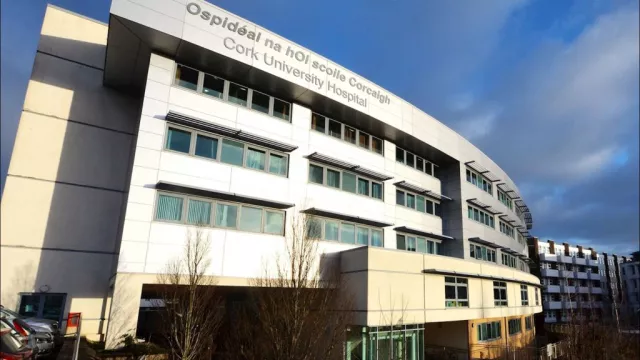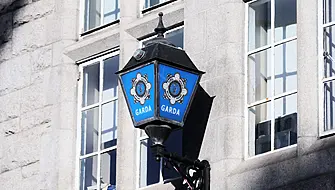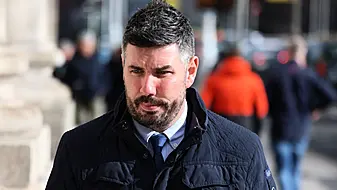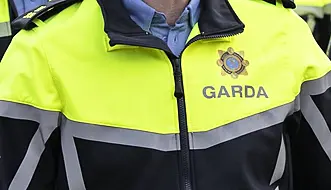The widow of a 34-year-old man who waited nine hours to see a doctor at a Cork hospital having suffered a tear in his aorta, and died after a CT scan was postponed because of a broken machine, is hoping to create more awareness of the condition that claimed his life.
Pat Murphy, who was the “doting” father of a 17-month-old boy, died from an aortic dissection.
The risk of dying can be as high as one per cent to three per cent per hour until the patient gets treatment. It is classed as a medical emergency and requires urgent intervention.
The main symptom is sudden severe tearing pain in your chest or your upper back. The symptoms can be mistaken for a heart attack, acute gastritis, lung pain or kidney stones. Patients can be incorrectly triaged in hospitals as a result of its similarity to other conditions leading to vital hours being lost in what can be a deadly condition.
A two-day inquest at Cork Coroner’s Court this week heard that Pat passed away at Cork University Hospital (CUH) on September 3rd.
He had arrived at CUH at 12.55am on September 2nd.
Day of incident
The chemical engineer, who was originally from Donoughmore in Cork, was watching a World Cup qualifying match between Ireland and Portugal with his wife Keerti Murphy earlier that evening when he became to experience chest and neck pain.
Keerti said that one minute Pat was animated about the possibility of Cristiano Ronaldo scoring a goal and “telling him off” in their living room. Then he was in agonising pain in his chest, neck and back.
Cork Coroner’s Court heard that the South Doc Service was contacted and an ambulance called. However, after forty minutes of waiting for the ambulance a decision was made, in conjunction with the National Ambulance Service, that Pat travel to hospital by taxi rather than delay him further.
Coroner Philip Comyn was then told of a litany of mistakes that meant Pat did not receive a potentially life-saving operation on the day of his admission.
Keerti movingly recalled getting messages from her husband who informed her that he was in such extreme pain that he had gotten off his chair to lie on the ground in the emergency department.
Pat said he was waiting for a CT scan for possible kidney stones. His scan was pushed back until the following day as one of two scanners at the hospital was broken. Later that day he suffered seizures.
In the early hours of September 3rd, 2021 Pat was taken in to emergency cardiac surgery after an urgent CT scan confirmed a a dissecting aortic aneurysm which had ruptured. The surgery was unsuccessful and Pat died in the early afternoon the following day.
Keerti and the Murphy family hope that lessons will be learned from Patrick’s death, particularly as they have received an apology from CUH for the failings in his care.
They had asked the jurors in the case to return recommendations that they feel “had the potential to make real change.”
Doireann O’Mahony, Junior Counsel, representing the family hospital management asked CUH to audit radiological infrastructure to identify areas for improvement and investment.
Her second recommendation was that CUH introduce a dedicated aortic dissection policy. The third recommendation she suggested involved improved learning at the hospital in relation to the condition.
She also called for more training on aortic dissection at CUH so that Pat’s death would not be in vain.
However, the jurors on Thursday only brought back a recommendation that CUH ‘urgently’ move to an electronic record system after gaps were found in the records relating to the care of Mr Murphy.
In a statement, the Murphy family say that they “still hope that CUH will engage with them to improve outcomes for others affected by aortic dissection.”
Roger Murray, SC for the Murphy family said that evidence was heard over two days that this was a treatable, survivable condition.
“An aortic dissection is rare, but the incidence could be as high as six in 100,000 people. That means in a county like Cork you could expect to see 36 cases a year.
It is very important that there is learning from this. That is the one point of solace that the family will take. That the hospital have said that they will learn lessons from what happened to Patrick.
"They now have a policy in relation to disseminating information in relation to the tragic outcome here. They have spoken about him at meetings, and the evidence that was heard over two days: narrowing, difficult evidence hopefully will establish that this is something that will create awareness, will raise awareness and that’s the one legacy they hope can be achieved for Patrick from these events."
Mr Murray said that aortic dissection can be detected by changes in blood pressure and that there was every possibility of survival with Pat if a diagnosis had been made on time and surgical intervention introduced earlier.
He added that Pat was triaged as a category three patient when he should have been viewed as more of a priority patient.
“He should have been in category 2. He should have been seen by a doctor within the hour. A and E’s are busy places. That is accepted. But emergencies should always be identified as such and appropriate action taken.”
The inquest established that in 2021 CUH had three doctors on duty at night in the A&E Department, two registrars and one junior doctor with a consultant on call. At times staffing pressures were such that there might be one registrar and two junior doctors/senior house officers. (SHO’s).
The numbers have now increased to five doctors, registrars and three junior doctors with a larger number of consultants also available.
Other improvements implemented at CUH include special orientation training for doctors on aortic dissection, the hiring of more senior doctors and increased case discussions, an expanded email reference platform and the allocating of consultants to specific areas.
Broken scanners
One of the two CT scanners in place at CUH was broken for a period of 21 hours when Pat Murphy was in hospital.
The two scanners have now been replaced and a third added. One senior consultant at CUH told the inquest that they would have ‘six’ scanners if they could.
Meanwhile, the inquest heard that Pat met his wife Keerti Krishnan when they both studied at Lancaster University in the UK. Pat had a PHD in Science.
Keerti recalled happier days including the couple’s three weddings the last one of which was celebrated in her native India.
She told the jurors of the last day that she, Pat and their toddler spent as a family prior to his unexpected death. Keersti said the couple had gone to Cork city centre for an appointment. They stopped outside Cork City Hall to show their son where his grand dad Willie had worked.
“I vividly remember my son’s little fingers wrapped around Pat’s forefinger, cautiously looking at ongoing buses, cars and trucks that zoomed past us — the reassured hold on his father.
I have a library in my mind and on my phone, of the two of them linked like this in the 17 months they had together. To think this was the last physical link, was unthinkable.”







